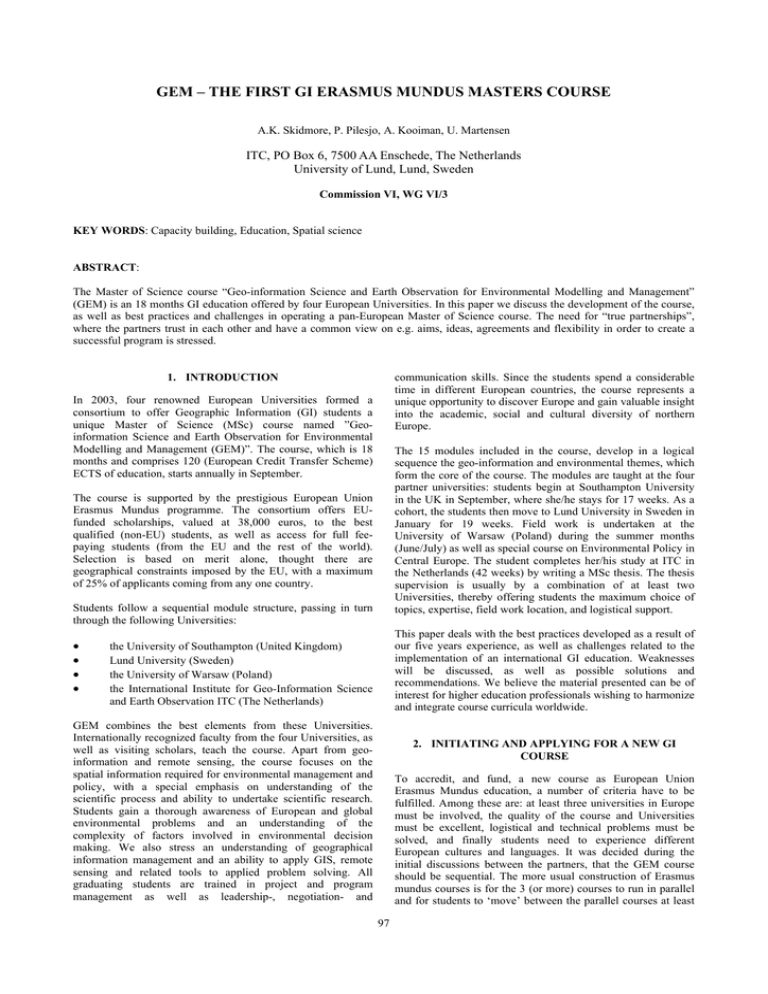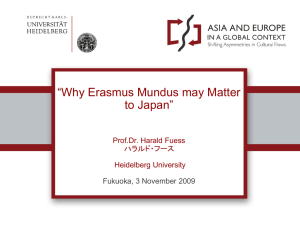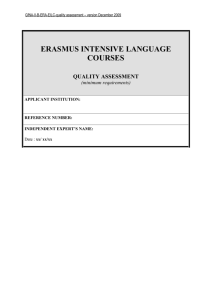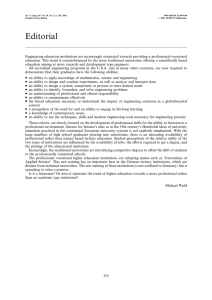GEM – THE FIRST GI ERASMUS MUNDUS MASTERS COURSE
advertisement

GEM – THE FIRST GI ERASMUS MUNDUS MASTERS COURSE A.K. Skidmore, P. Pilesjo, A. Kooiman, U. Martensen ITC, PO Box 6, 7500 AA Enschede, The Netherlands University of Lund, Lund, Sweden Commission VI, WG VI/3 KEY WORDS: Capacity building, Education, Spatial science ABSTRACT: The Master of Science course “Geo-information Science and Earth Observation for Environmental Modelling and Management” (GEM) is an 18 months GI education offered by four European Universities. In this paper we discuss the development of the course, as well as best practices and challenges in operating a pan-European Master of Science course. The need for “true partnerships”, where the partners trust in each other and have a common view on e.g. aims, ideas, agreements and flexibility in order to create a successful program is stressed. communication skills. Since the students spend a considerable time in different European countries, the course represents a unique opportunity to discover Europe and gain valuable insight into the academic, social and cultural diversity of northern Europe. 1. INTRODUCTION In 2003, four renowned European Universities formed a consortium to offer Geographic Information (GI) students a unique Master of Science (MSc) course named ”Geoinformation Science and Earth Observation for Environmental Modelling and Management (GEM)”. The course, which is 18 months and comprises 120 (European Credit Transfer Scheme) ECTS of education, starts annually in September. The 15 modules included in the course, develop in a logical sequence the geo-information and environmental themes, which form the core of the course. The modules are taught at the four partner universities: students begin at Southampton University in the UK in September, where she/he stays for 17 weeks. As a cohort, the students then move to Lund University in Sweden in January for 19 weeks. Field work is undertaken at the University of Warsaw (Poland) during the summer months (June/July) as well as special course on Environmental Policy in Central Europe. The student completes her/his study at ITC in the Netherlands (42 weeks) by writing a MSc thesis. The thesis supervision is usually by a combination of at least two Universities, thereby offering students the maximum choice of topics, expertise, field work location, and logistical support. The course is supported by the prestigious European Union Erasmus Mundus programme. The consortium offers EUfunded scholarships, valued at 38,000 euros, to the best qualified (non-EU) students, as well as access for full feepaying students (from the EU and the rest of the world). Selection is based on merit alone, thought there are geographical constraints imposed by the EU, with a maximum of 25% of applicants coming from any one country. Students follow a sequential module structure, passing in turn through the following Universities: • • • • This paper deals with the best practices developed as a result of our five years experience, as well as challenges related to the implementation of an international GI education. Weaknesses will be discussed, as well as possible solutions and recommendations. We believe the material presented can be of interest for higher education professionals wishing to harmonize and integrate course curricula worldwide. the University of Southampton (United Kingdom) Lund University (Sweden) the University of Warsaw (Poland) the International Institute for Geo-Information Science and Earth Observation ITC (The Netherlands) GEM combines the best elements from these Universities. Internationally recognized faculty from the four Universities, as well as visiting scholars, teach the course. Apart from geoinformation and remote sensing, the course focuses on the spatial information required for environmental management and policy, with a special emphasis on understanding of the scientific process and ability to undertake scientific research. Students gain a thorough awareness of European and global environmental problems and an understanding of the complexity of factors involved in environmental decision making. We also stress an understanding of geographical information management and an ability to apply GIS, remote sensing and related tools to applied problem solving. All graduating students are trained in project and program management as well as leadership-, negotiation- and 2. INITIATING AND APPLYING FOR A NEW GI COURSE To accredit, and fund, a new course as European Union Erasmus Mundus education, a number of criteria have to be fulfilled. Among these are: at least three universities in Europe must be involved, the quality of the course and Universities must be excellent, logistical and technical problems must be solved, and finally students need to experience different European cultures and languages. It was decided during the initial discussions between the partners, that the GEM course should be sequential. The more usual construction of Erasmus mundus courses is for the 3 (or more) courses to run in parallel and for students to ‘move’ between the parallel courses at least 97 The International Archives of the Photogrammetry, Remote Sensing and Spatial Information Sciences. Vol. XXXVII. Part B6a. Beijing 2008 once in order to satisfy EU requirements – the so-called ‘parallel construction’. Both parallel and sequential courses have their positive elements and drawbacks, which are discussed further below. course, and received scholarships from the consortium, a cost shared between the partner universities. We highly recommend this way of testing the logistics and viability of new courses. It is a challenge to create a new international course, which is both unique and which takes advantage of “best practice” and the specialized skills available at the different partner institutions. In the GEM course, our ‘silver thread’ or ‘red line’ in curriculum development involves linking technical skills in spatial science with environmental management and policy. Though the partners are all recognized specialists in remote sensing and GIS, the Universities still are specialized in a limited number of research areas, and have developed clear skill sets which we were able to join to create a superior course. This, in combination with student programs offering courses in different EU languages and culture, makes GEM attractive for international students, as well as meeting EU requirements for Erasmus mundus funding. 3. TUITION FEES, GRADING AND DEGREE ASSESSMENT As countries in Europe differ in their tuition fee policy, agreeing to an appropriate fee level becomes an issue when starting joint programs and courses. National and institutional fee policies are dynamic, so a sustainable solution which avoids frequent updating of the memorandum of agreement (MoA) is a key concern for an international joint course. An example of different tuition fee policies is listed below: • • • • Naturally, a 120 ECTS MSc program takes some time to develop. An existing network of professors, staff, as well as relevant research groups amongst the potential partner universities, is crucial in order to develop the proposal as well as successfully apply for an EU contract. In other words, the partners must be recognized as excellent in their field of expertise (in our case spatial and environmental sciences). A flexible and cooperative working relationship between the staff involved in the course, and especially the initial ‘champions’ of the project (in this case Professors from the universities of Southampton, Lund, Warsaw and ITC) was also critica to the commitment and developm,ent of the proposal and course. A key factor in the development of our eventually successful application, was the unconditional support by each partner’s Rector or Vice-Chancellor. The VCs/Rectors were supportive primarily because the GEM course melded with their institutional objectives. In the case of GEM, the different partner universities have focused on different target groups during student recruitment: • • • • UK charges full commercial fees (about 20 k Euros for an MSc) The Netherlands charges a medium rate (about 10 k Euros) Sweden has no charges Poland is moving to a cost recovery system A requirement of the EU Erasmus mundus program is that students must be charged a single fee for the entire course. Individual fees for each partner would have been complicated to administer, and is not an indication of a joint course. Consequently, all financial matters are arranged at a “consortium level”. It is the consortium that offers the course, charges the students, and splits revenues amongst the partners. In the case of GEM, the partners agreed to a commercial fee for the course: The rate for EU students was set to 3,750 Euros and for non-EU students the fee was set at 9,500 Euros. Lund University, which is not allowed to charge fees, is reimbursed for “services”, and the other partners split revenues according to teaching load. Final “balancing” of teaching load is arranged through supervision of theses. Since the cooperation between the partners is, and probably has to be, based on trust and flexibility, it was agreed to avoid a strict accounting system. Partners are reimbursed for costs, and these are not necessarily equal. A 10% overhead for management is also paid to ITC. As many EU countries do not charge fees, or charge a very low fee, it became apparent that the for EU students, the consortium had priced itself out of the market. The consortium therefore introduced 10 scholarships which paid fees for the EU students, in order to boost the number of EU students in the course. ITC has concentrated on developing countries Southampton University has concentrated on the Commonwealth and US Lund University has concentrated on EU and China Warsaw University has concentrated on Central Europe Students, who have diverse backgrounds and experiences, require logistical support, especially in relation to regular (national) students with whom most Universities have most experience. Even if partner Universities regularly handle international education logistics (at ITC for example, the majority of the students are from outside Europe) multiple preparatory meetings are required each year to ensure smooth operations. For example, a Memorandum of Agreement has to be written and signed by four partner Universities, and issues such as tuition fees, visas, grading, degree award, and quality assurance (see below) need to be solved. The MoA is a legal document, binding the partners to a multi-year contract, and clearly laying out obligations and responsibilities, as well as how to share the benefits of the course. A challenge of joint programs is developing a transparent and equivalent grading procedure. Almost all countries have developed grading systems, which are well known to teaching staff, and difficult to modify. As a result of the ongoing “Bologna process” in Europe, the consortium adopted a system is based on the so-called European Credit Transfer System (ECTS). However, the ECTS system is in conflict with some countries legislation (e.g., Sweden), and the implementation procedure will no doubt take a long time. Thus, it was decided to maintain the national grading systems, and to translate national grades into the indicative ECTS equivalent. The students receive their grades both in the national system (for example UK grading for UK modules, Swedish grading for Swedish modules etc.) as well as the ECTS equivalent. The challenge arose when the national system is ‘coarser’ than the ECTS grading (for example, in Sweden the national system reports only fail, pass or high pass). For Sweden, the national grades are firstly awarded based on the ECTS grading, and then translated to the national system. For other partners, where the In order to “test” the different components of the course before the applying to the EU, the consortium decided to run a “trial” course with 6 participants, before launching the full scale education (today, approximately 45 students, with a total budget of about 2 million euros per year are enrolled in the GEM course). Six students were initially selected for this “trial” 98 The International Archives of the Photogrammetry, Remote Sensing and Spatial Information Sciences. Vol. XXXVII. Part B6a. Beijing 2008 ECTS grading is coarser than the national system (such as the UK, where the grades are reported in percentages), the national grades are translated to ECTS grades. course being consistent as the same modules are taught to all students leading to a integrated program. In addition, sequential courses are easier to administer as it is possible to develop consistent and high quality services for all students. For example, rather than the students having to organize their own visa (the default case with parallel courses), the administrators for a sequential course can organize visa issuance for all students in the cohort via the relevant consular service. In other words, the consular service at an embassy is able to treat the cohort as a ‘batch’, and information can be readily supplied to support the visa procedure. Another example of the superior logistical efficiency of a sequential course is financial control – the student accounts may be set up for students prior to their arrival in Europe, and costs are known for each component of the course. The parallel construction has the advantage of flexibility – students may choose the sequence of modules that best suits their requirements. In practice, students from EU countries find the parallel course structure particularly attractive, as they can undertake 50% of their course in their home country university before moving to another European country in order to complete their studies. There is an ongoing discussion at European level about the ECTS credits, and ECTS grading system. EU countries and universities assign work loads to an ECTS credit unit (the rate is normally 25-30 student working hours per credit) and different teacher apply the grading system in a subjective manner. The risk of inflation in ECTS grading, where some universities award more credits than others, is obvious, especially if a University considers itself ‘better’ or ‘superior’ to other Universities. The main challenge for grading in a systematic manner is that ECTS grading is a relative grading system. If this is applied at a “course level”, the number of good students should be equal to the number of weak students. However, as Erasmus mundus courses attract an elite cohort of students, a bias would occur, with the ‘weaker’ students receiving lower grades compared to a non-selected course. A less strict approach is to use all European students as the reference group. The teacher can then, based on experience, judge a current group in relation to all other students that she/he has knowledge about. Many other challenges must be considered for a new MSc course operated by multiple partner Universities. Examples include developing a common course calendar, setting requirements for admission, how to deal with progression in case of failure of a module, evaluating the quality of teaching, and monitoring and then improving curriculum. The GEM consortium uses structures existing within the partner organizations as much as possible, and applies the “most stringent” policy among partners regarding admission and progression. In other words, if a partner has a stricter policy thatn other partners (for example demanding a 7.5 TOEFL English test) then the most stringent requriemetn is adopted by the other partners. In addition, the partners observe institutional rules and requirements and, if possible, use Bologna recommendations regarding teaching evaluations and curriculum development. These agreements are formalized in the Memorandum of Agreement. Another common challenge within Europe (and the rest of the World) is a mechanism to award joint degrees between multiple Universities. A single joint degree can be defined as a degree that is awarded to a successful student, with the joint degree being “jointly” signed and certified by all partner universities. However, joint degrees may not be awarded in some European countries: For example, Sweden and The Netherlands do not permit the award of joint degrees under national legislation. The alternative manner in which a student’s participation in a joint course may be acknowledged is to award multiple degrees. In other words, each partner awards a degree with the same degree title and academic qualification. Since joint degrees are not allowed in Sweden and the Netherlands, GEM awards a multiple degree. However, a joint diploma supplement (also known as course record, or academic transcript) is attached to the degree, detailing the grades of the passed modules. The module results are presented both as national system grades, as well as according to the ECTS grading system (see above). The GEM partners have agreed to award a joint degree as soon as the legislation is adapted in Sweden and The Netherlands, and agreement has become a contractual obligation as the Memorandum of Agreement (MoA) signed by the Rectors and Vice-Chancellors of the partner Universities. The European Union demands that a joint degree be issued for a student successfully completing an Erasmus mundus Masters program, but if national legislation prevents this (e.g. Sweden and The Netherlands in the case of GEM), then the EU permits a multiple degree. The development of a joint curriculum is requires the curriculum to be adjusted to fit national requirements. Our curriculum development procedure involved a series of discussions to resolve standards between the partner Universities with a focus on: • • • how to write a curriculum (we adopted the ITC method as a standard, but adjusted it to conform to the Bologna ECTS credit system), different ways of teaching and learning, different examination procedures. It is well known that different teachers and different cultures have different views on the “best way” of learning. This is not a problem if the learning outcomes can be agreed between the partner Universities. Then a mixture of pedagogic approaches and examination becomes a strength, and not a weakness. In other words, when writing the curriculum, we used a “Bologna influenced” template, focusing on outcome statements. 4. CURRICULUM DEVELOPMENT AND IMPLEMENTATION As mentioned above, the Erasmus mundus courses may be categorized as either sequential or parallel. The GEM course is sequential, meaning there is one course, and the cohort moves together from one University to the next, and follow the same coursework modules. In contrast, a parallel course involves each partner university presenting the same module, so students may opt to take the course at the location of their choice. The didactic advantages of the sequential course is that it is efficient (only one course is taught, and there is no redundancy by teaching the same material three times), as well as a sequential Finally, a critical element of curriculum development is the quality assurance of the course evaluations, and continual course improvement based on feedback from student and peer review. The quality of teaching in the modules is assured through class observations, particularly inter-institute observations. Further, the quality of teaching is assessed using student questionnaires, which are assembled and processed for 99 The International Archives of the Photogrammetry, Remote Sensing and Spatial Information Sciences. Vol. XXXVII. Part B6a. Beijing 2008 every MSc module each year. The feedback forms are designed to gather information on how the modules can be improved. Finally the entire course is reviewed annually by an external expert and the report used to improve practices and ensure the EU quality criteria are met. The creation of the consortium and the development and launching of a joint MSc course has highlighted a number of important issues necessary for a successful outcome. According to our experience the most important issues, which also are our recommendations to colleagues initialising international remote sensing and GIS educations, include: As part of Eramus mundus, non-EU Universities may be invited to participate. For the GEM consortium, non-EU partner Universities include from Australia The University of New South Wales and the University of Sydney, from the US Boston University, and finally Tsinghua University from China. NonEU partners receive a payment from the EU, receive Erasmus mundus mundus students for thesis coursework, and may also send their Professors on academic exchange to the EU partner Universities. The cooperation between the EU and non-EU Universities is encouraging research cooperation and collaboration in projects, PhD-level, as well as of course directly as part of MSc thesis supervision. • • • • • • • Always build on a true partnership Appreciate and encourage different ideas and aims, and remain flexible in making agreements and implementing practical outcomes Carefully define quality assurance and sign a legal contract such as a Memorandum of Agreement Accept and appreciate the differences amongst partners Maintain standards Use the ‘most stringent’ policy in implementing quality assurance Adopt and follow recommendations on best practice . 5. STRATEGIC BENEFITS AND RECOMMENDATIONS 6. CONCLUSIONS There are many strategic benefits of a joint course focused on GIS and remote sensing, and environmental management. Some of the most obvious advantages are: • • • • • • • An initiative at teaching a pan-European GIS and remote sensing course entitled “Geo-information Science and Earth Observation for Environmental Modelling and Management” (GEM) is described. Four leading remote sensing and GIS Universities in Europe have combined to teach an 18 month sequential course, which is financially and logistically supported by the European Union Erasmus mundus program. This EU program promotes excellence in European Higher Education, and offers high value scholarships to exceptional student candidates. The Erasmus mundus program also promotes cultural and language experiences amongst the participating students. The collaboration allows for exchange of experience at European level and between different geographic information and remote sensing disciplines European spatial science education is strengthened and promoted Co-operation yields “best practice” and higher quality Intercultural understanding through co-operation is promoted – both within Europe for the students as well as between students, and between staff and students. Developing an alumni network for future cooperation in research and advice. Encouraging joint research activities between partners, as well as targeted and strategic partners outside Europe with whom alumni work after graduation. Erasmus Mundus is a recognised stamp of quality and prestige, as well as providing funding In this paper, we discuss the challenges and solutions in initiating a joint European Masters course. Such a course requires hard work and dedication by the participating staff to set up, and then run. Student numbers have increased from 6 students to a current (2008) cohort of 45. The GEM course has been cited as developing a number of ‘best practices’ by the European Union. 100




